写在前面
这是PB案例学习笔记系列文章的第14篇,该系列文章适合具有一定PB基础的读者。
通过一个个由浅入深的编程实战案例学习,提高编程技巧,以保证小伙伴们能应付公司的各种开发需求。
文章中设计到的源码,小凡都上传到了gitee代码仓库https://gitee.com/xiezhr/pb-project-example.git
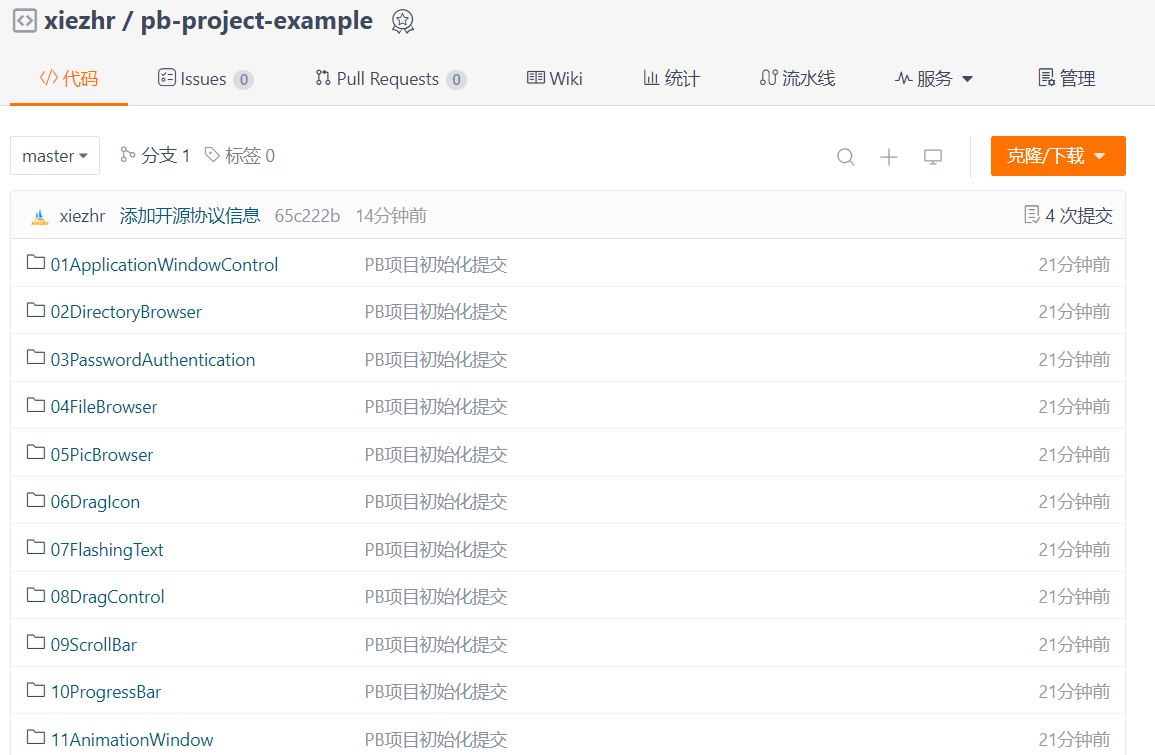
需要源代码的小伙伴们可以自行下载查看,后续文章涉及到的案例代码也都会提交到这个仓库【**pb-project-example**】
如果对小伙伴有所帮助,希望能给一个小星星⭐支持一下小凡。
一、小目标
这篇文章我们制作一个限制使用次数和日期的窗口。在实际工作中的使用场景是:当我们程序完成后需要将它提供给
客户试用时可以用到。用户通过试用,觉得程序🆗了,再进行购买。
案例中我们需要用到Profilestring() 和 Profileint() 读取和操作配置文件来记录使用次数和时间。
然后利用结构来进行数据交互。用到的这些我们会在后面的小节中详细介绍
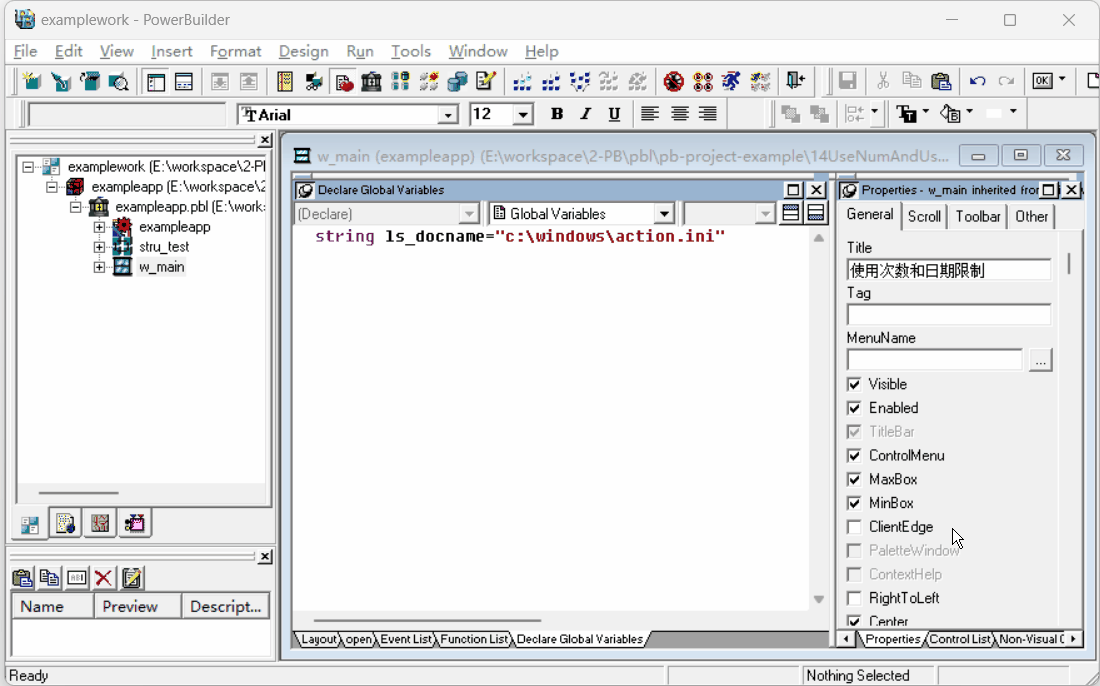
二、 配置文件读取函数
2.1 ProfileString函数
获取配置文件中指定节点内容
① 语法
ProfileString(filename,nodename,default_value)
② 参数
filename–> 配置文件名称nodename–> 配置文件中的节点名称default_value–> 未找到指定的节或键,则返回的默认值
③ 返回
- 返回值:string
- 如果找到指定的节和键,则返回对应的值
- 如果未找到指定的节或键,则返回默认值default_value
④ 举个栗子
我们来获取项目根目录下xiezhr.in配置文件中的数据库用户名、密码、连接信息
ls_username = ProfileString("xiezhr.ini","transaction","username","scott")
ls_password = ProfileString("xiezhr.ini","transaction","password","tiger")
ls_servername = ProfileString("xiezhr.ini","transaction","servername","127.0.0.1:1521/orcl")
2.2 SetProfileString 函数
设置配置文件中指定节点内容
① 语法
SetProfileString(filename,nodename,sourcename,value)
② 参数
filename–> 配置文件名称nodename–>节点名称sourcename–>节点下目标位置名称value--> 需要设置的值
③ 返回
- 返回值:
Integer
- 如果成功写入值,则返回0
- 如果写入失败,则返回-1
④ 举个栗子
我们修改项目更目录下xiezhr.ini配置文件内容,将username值设置成xiezhr
SetProfileString('xiezhr.ini','transaction','username',xiezhr')
三、结构介绍
结构是多个相关变量的集合,这些变量可以具有相同的数据类型也可以具有不同的数据类型。
结构的所有元素可以作为一个整体引用
结构类型
不与应用程序中的任何具体对象相关联,并且可以在应用程序的任何地方使用
注: 在定义结构时,如果定义的结构具有通用性并且在应用程序的任何地方都可以用到它,则把它定义为全程结构
如果要定义的结构只是用于某一特殊类型的对象,则定义为对象级结构即可
四、创建程序基本框架
在前面小节中已经把案例用到的相关知识做了简单介绍,还有一些文件打开FileOpen(),文件写入FileWrite()
在之前的文章中已经提到过,这里就不赘述了。接下来,我们就开始实操了
① 新建examplework工作区
② 新建exampleapp应用
③ 新建w_main窗口
④ 控件布局
在窗口中建立4个GroupBox控件和4个StaticEdit控件,调整控件大小位置,并修改text属性内容
修改完如下图所示,控件分别命名为gb_1 ~ gb_4 和st_1 ~ st_4
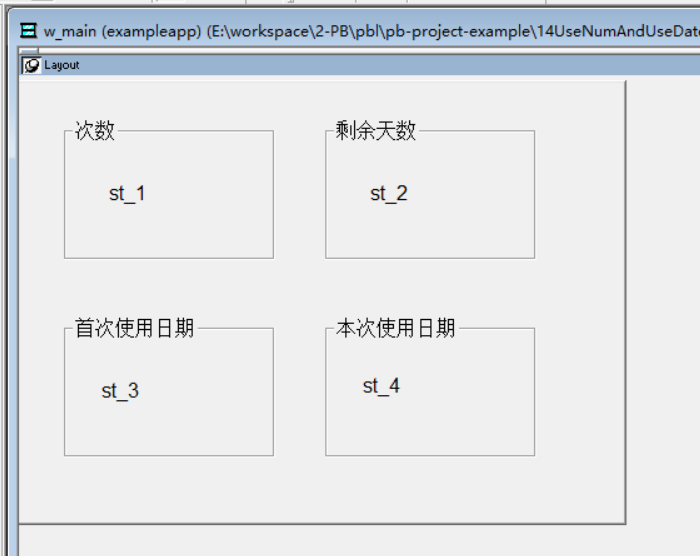
⑤ 保存窗口
五、建立结构
① 添加结构
单击工具栏File—>New 命令,在弹出的New对话框中选择PB Object 选项卡中的Structure图标,单击【ok】按钮完成创建
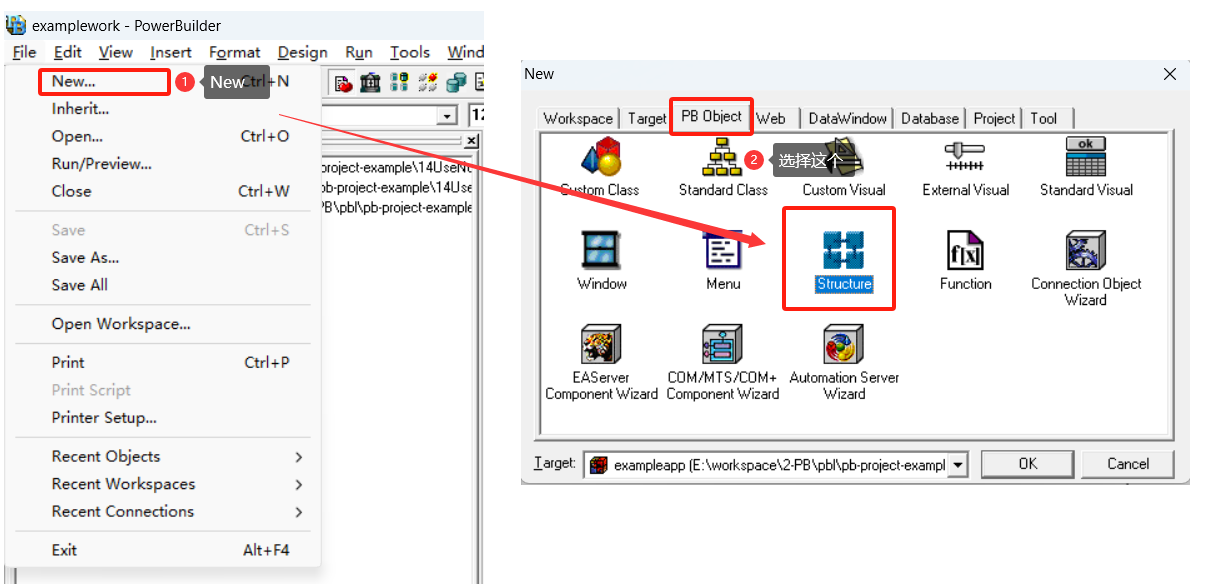
② 定义结构
上一步中单击【ok】按钮之后,会出现结构定义画版,具体如下图所示,在滑板中定义结构
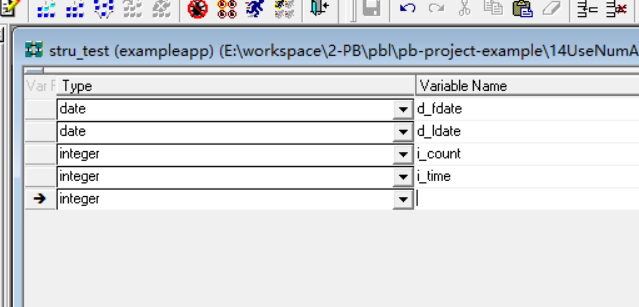
③ 保存为结构stru_test
定义完成后将结构命名为stru_test
六、编写代码
① 定义全局变量
双击系统视窗中exampleapp应用图标,在Declare Global Variables选项卡中输入如下代码
string ls_docname="c:\windows\action.ini"
② 定义实例变量
在Declare Instance Variables 选项卡中添加如下代码
date id_firstdate
date id_lastdate
integer ii_CanUseDays
integer ii_count
stru_test stru
③ 在exampleapp 应用中添加u_openwin(integer ai_usedays) return boolean 函数,代码如下
if ai_usedays>ii_canusedays then
return false
else
stru.d_fdate=id_firstdate
stru.d_ldate=id_lastdate
stru.i_time=ii_canusedays - ai_usedays
stru.i_count=ii_count
return true
end if
④ 在exampleapp应用中添加u_lastdays() return integer 函数,代码如下
boolean lb_exist
int li_ret
id_lastdate=date(profilestring(ls_docname, "data", "last_data", string(today())))
id_firstdate=date(profilestring(ls_docname, "data", "first_data", string(today())))
ii_CanUseDays=profileint(ls_docname, "data", "times", 30)
li_ret=DaysAfter(id_lastdate,today())
if li_ret < 0 then
return li_ret
else
id_lastdate=today()
setprofilestring(ls_docname, "data", "last_data", string(id_lastdate))
li_ret=DaysAfter(id_firstdate,id_lastdate)
return li_ret
end if
⑤ 在exampleapp应用中添加u_newfile() return integer 函数,代码如下
integer li_FileNum
boolean lb_exist
lb_exist = FileExists(ls_docname)
IF lb_exist THEN
ii_count=Profileint ( ls_docname, "data", "count", 0 )
ii_count++
SetProfileString(ls_docname, "data", "count", string(ii_count))
return ii_count
else
li_FileNum = FileOpen(ls_docname,LineMode!, Write!, Shared! , Append!)
FileWrite(li_FileNum, "[data]~r~nfirst_data = "+string(today())+"~r~n"+&
"last_data = "+string(today())+"~r~ntimes = 30~r~ncount = 0")
return 0
end if
⑥ 在exampleapp 应用的open 时间中添加如下代码
int li_usedays
this.u_newfile()
li_usedays=this.u_lastdays()
if li_usedays < 0 then
messagebox("提示信息","您推迟了系统日期"+string(abs(li_usedays))+"天,系统无法加载!",stopsign!)
return
else
if this.u_openwin(li_usedays) then
openwithparm(w_main,stru)
else
messagebox("提示信息","请原谅,您的软件已经到期!")
end if
end if
⑦ 在w_main窗口的open事件中添加如下代码
stru_test stru
string ls_days
stru=message.PowerObjectparm
st_1.text=string(stru.i_count)
st_2.text=string(stru.i_time)
st_3.text=string(stru.d_fdate)
st_4.text=string(stru.d_ldate)
七、运行程序
代码写完了,我们验证一下看看程序能不能达到我们的预期效果

本期内容到这儿就结束了,希望对您有所帮助 ★,°:.☆( ̄▽ ̄)/$:.°★ 。
我们下期再见